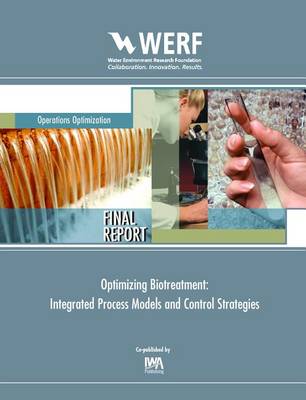WERF Research Report
3 total works
Sensing and Control Systems
by Robert D. Hill, R. C. Manross, E. V. Davidson, T. M. Palmer, M. C. Ross, and Stephen G. Nutt
Published 31 August 2002
The objective of this research was to assess and document state-of-the-art of wastewater treatment plant sensing and control systems to discover successful practices that can be replicated by other facilities interested in automating. The research was based on the literature, the experience of the project and advisory teams, and onsite surveys. The project focused on the best examples of applied sensors, control strategies, and computerized process control in wastewater treatment plants. An instrumentation and control survey designed to assess the current state of automation showed that most instruments are used for the simpler measurements, and most respondents justified installing automation systems because of cost savings, though less than 10% of the facilities had data demonstrating these savings. In addition, the survey showed that wastewater treatment facilities that do use automation and remote monitoring during at least part of the day do achieve great cost savings. The 25 field surveys done to gather site-specific details provided useful data on both successful and unsuccessful automation practices. The project team found a large number of control strategies not commonly documented in current literature. Critical components were documented, and when costs and savings were known, these values were also reported. The report lists the 10 factors important for control system success, which resulted from factors identified by attendees at a WEFTEC 2000 workshop, combined with data from the field surveys. Almost all these factors relate to organizational and management rather than technical issues. This report also identifies needs that must be met if the full potential of wastewater treatment sensing and control systems is to be realized. While some of these needs are technical, perhaps the most important need is for continued demonstration of the real-world benefits of automated control. Though this project identified many instances where automation has realized significant benefits, many more cases comparing the costs and performance of a WWTP before and after implementation of a comprehensive system will be needed to convince the wastewater industry of the future for sensing and control systems. This publication can also be purchased and downloaded via Pay Per View on Water Intelligence Online - click on the Pay Per View icon below
The design of wastewater treatment plants with redundancy to assure a quality end product may be in conflict with efforts to assure effectiveness. Redundancy of major system components is to assure compliance with regulations and protection of the environment and the health and safety of the public and treatment plant staff. However, the capital costs and maintenance associated with redundant equipment does not necessarily enhance facility performance. There are a number of forces driving the level of redundancy in plant designs. Federal and state compliance regulations and the design engineer?s past experiences will influence the plant design. To some extent the plant staff may also provide input into the plant design and, therefore, contributes to the redundancy. This report determines alternative methods to address treatment plant redundancy, including examples of methods currently in place and, ideally, insight on the premises leading to these applications. A secondary objective is to identify the similarities and differences in redundancy requirements associated with federal and state regulatory agencies. This publication can also be purchased and downloaded via Pay Per View on Water Intelligence Online - click on the Pay Per View icon below
Available online as an eBook only.
The overall objective of this research project is to develop and implement model-based control strategies for improving biological treatment and document the methodology, benefits, and effort required. The project phase documented in this report include performing a literature review, installing extensive instrumentation at a full-scale advanced wastewater treatment facility, and developing real-time, dynamic models for biological nutrient removal that are suitable for control.
The literature review was published as a separate report entitled Model-Based Control: Literature Review and Primer. It provides a detailed description of model predictive control and examines case studies from the process industries and the environment utility industry. Considerable on-line analytical instrumentation was installed at the Stamford WPCA wastewater treatment plant where all the full-scale experimental work was performed. The instrumentation includes five ammonia, six nitrate/nitrite, one suspended solids, four dissolved oxygen, and two ORP analyzers. The analyzers have performed reliably and accurately with minimal periodic maintenance.
Artificial neural network models were developed for the nitrification and denitrification processes. These models provide adequately accurate results for the purpose of control. However, additional field work will be required to collect data with sufficient variability to include the effects of some parameters known to affect the nitrification and denitrification processes.
The overall objective of this research project is to develop and implement model-based control strategies for improving biological treatment and document the methodology, benefits, and effort required. The project phase documented in this report include performing a literature review, installing extensive instrumentation at a full-scale advanced wastewater treatment facility, and developing real-time, dynamic models for biological nutrient removal that are suitable for control.
The literature review was published as a separate report entitled Model-Based Control: Literature Review and Primer. It provides a detailed description of model predictive control and examines case studies from the process industries and the environment utility industry. Considerable on-line analytical instrumentation was installed at the Stamford WPCA wastewater treatment plant where all the full-scale experimental work was performed. The instrumentation includes five ammonia, six nitrate/nitrite, one suspended solids, four dissolved oxygen, and two ORP analyzers. The analyzers have performed reliably and accurately with minimal periodic maintenance.
Artificial neural network models were developed for the nitrification and denitrification processes. These models provide adequately accurate results for the purpose of control. However, additional field work will be required to collect data with sufficient variability to include the effects of some parameters known to affect the nitrification and denitrification processes.

